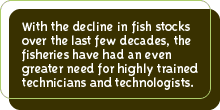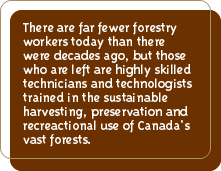|
Though it seems a bit cliched to say that the Canadian
economy is based on reaping the bounty of the land and sea, like many
clichés, it happens to be true. For centuries, immigrants came to this
corner of the New World seeking a patch of land to till, or as safe
anchorage for their fishing boats. The first European visitors to Canadian
shores - the Norsemen of the eleventh century - came with agriculture
and not conquest in mind.  The
fishing fleets of Brittany and Wales soon followed. They harvested the
rich waters of the Grand Banks in order to fill the Friday dinner plates
of Catholic Europe. Basque sailors set up whaling stations in what is
now Newfoundland and Nova Scotia. According to legend, when the great
explorer John Cabot sailed westward in 1497, he was guided by Breton
fishing charts. The
fishing fleets of Brittany and Wales soon followed. They harvested the
rich waters of the Grand Banks in order to fill the Friday dinner plates
of Catholic Europe. Basque sailors set up whaling stations in what is
now Newfoundland and Nova Scotia. According to legend, when the great
explorer John Cabot sailed westward in 1497, he was guided by Breton
fishing charts.
By the eighteenth century, the establishment of New
France and British North America added furs and timber to the European
sailing ships, and the long list of the colony's exports. Still the
immigrants came, pushing ever westward to the Selkirk settlement and
then to the heart of the Prairies, cutting down trees and sinking their
plows into the rich soil along the way.
 Today,
Canada is one of the world's leading exporters of wheat and corn despite
the fact that less than five percent of the national labour force is
employed in agricultural production. It is humbling to realize that,
in this age of virtual reality, cloning, and space travel, the traditional
occupations upon which Canada was built still account for a large part
of the economy. Today,
Canada is one of the world's leading exporters of wheat and corn despite
the fact that less than five percent of the national labour force is
employed in agricultural production. It is humbling to realize that,
in this age of virtual reality, cloning, and space travel, the traditional
occupations upon which Canada was built still account for a large part
of the economy.
However, on the edge of the twenty-first century, occupations
in agriculture, fisheries, and forestry are far less traditional than
one would think. We have come a long way from the days when small, family-owned
farms were passed on from parents to children with no possibility for
the latter's education. Like everything else nowadays, agriculture is
high-tech. Computers are standard farm equipment - just like tractors
and combines - and understanding the latest advances in genetics and
bioscience are essential to running a successful agricultural operation.
With a growing population to feed and finite resources
to preserve, agriculture has left the old traditions behind in favour
of hard science. It has become a field for highly-trained specialists.
Today, raising crops is all about soil science, botany, and studies
of environmental impact. Livestock farming is as much a question of
veterinary science and genetics as herding and pasturage. Animal care,
agriculture and bioscience technicians and technologists play a huge
role in these areas.
A revolution in organic farming has created the need
for new techniques and technical specialists to raise crops the natural
way. Other types of agriculture, however, have become just as high-tech.
In the dairy industry, for example, milk production has been computerized
and involves the monitoring of individual cows throughout the production
and distribution process.
There's no limit to how advanced agricultural technology
may become (a Danish researcher has even developed a cheese simulator!),
and thus there's no limit to where careers in agriculture may lead.
With the decline in fish stocks over the last few decades,
the fisheries have had an even greater need for highly trained technicians and technologists. The industry has had to find
ways of doing more with less - of maximizing resources without doing
additional damage to fish stocks. Despite a recent decline in the fisheries'
workforce, or maybe because of it, the fishing industry has placed a
premium on skilled professionals trained in biology, technology, and
resource management.
trained technicians and technologists. The industry has had to find
ways of doing more with less - of maximizing resources without doing
additional damage to fish stocks. Despite a recent decline in the fisheries'
workforce, or maybe because of it, the fishing industry has placed a
premium on skilled professionals trained in biology, technology, and
resource management.
The fisheries' crisis has also led to a revolution
in aquaculture, the controlled cultivation of fish. The industry is
expected to grow from $220 million in 1992 to as much as $1 billion
in 2001, and for good reason. We have begun to understand that nature
is not an unlimited resource. Aquaculture is a technological answer
for sustainable development that requires specialists with wide-ranging
expertise in subjects from biology and genetics to resource maintenance.
This has led to increasing demand for trained aquaculture technicians
and technologists.
 The
forestry industry is undergoing a similar revolution. The old ways of
timber clear-cutting are simply too hard on forests, the underground
water table, and the environment in general. The demand for wood has
never been higher, but our forests have never been more endangered and,
as a consequence, there has never been a greater need for trained specialists
who can ensure that Canadian forests remain a sustainable natural resource.
There are far fewer forestry workers today than there were decades ago,
but those who are left are highly skilled technicians and technologists
trained in the sustainable harvesting, preservation, and recreational
use of Canada's vast forests. Forestry technicians and technologists
are at the forefront of this new way of harvesting the bounty of the
forest. The
forestry industry is undergoing a similar revolution. The old ways of
timber clear-cutting are simply too hard on forests, the underground
water table, and the environment in general. The demand for wood has
never been higher, but our forests have never been more endangered and,
as a consequence, there has never been a greater need for trained specialists
who can ensure that Canadian forests remain a sustainable natural resource.
There are far fewer forestry workers today than there were decades ago,
but those who are left are highly skilled technicians and technologists
trained in the sustainable harvesting, preservation, and recreational
use of Canada's vast forests. Forestry technicians and technologists
are at the forefront of this new way of harvesting the bounty of the
forest.
Canada was built by men and women who had a special
relationship with the land and sea. While the way we harvest has changed
tremendously in four centuries, that special relationship remains.

|